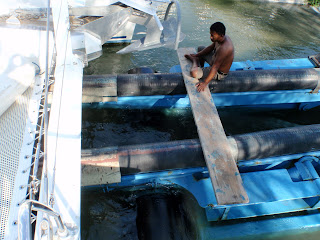There are 3 ways to lift out a boat. A Travelift, trailer, and crane. Our owners manual has a detailed section on using
the Travelift and crane but has nothing about the trailer.
 |
| We're tied to a tree and this trailer needs to be perfectly positioned |
I contacted Privilege about using the trailer and got a very
non-committal answer saying "we don't recommend it". Other catamarans however claim that it is the
preferred way to haul them out. In the past 10 years, we have been hauled out 8 times and always by a Travelift. We heard
the FULL MONTY, a privilege 48, was hauled
out with a trailer in Tahiti and cracked both their escape
hatches. In Australia,
we saw a Privilege 48 being hauled by a SeaLift trailer and it seemed to work
out fine. So we figured why not give it a try. It may also be a handy thing to know about for use in other parts of the world.
 |
| Trailer going down the ramp and under Tortuguita |
 |
| Pneumatic tubes (strapped to steel) that support the boat |
 |
| We're finally being lifted. |
They SeaLift goes down a ramp like a regular trailer and the
boat is positioned over 4 pneumatic tubes.
The Catamaran is lifted from under the deck and a monohull is lifted by
the sides of the hull. The trailer needs
to be submerged completely beneath the boat and due to the depth of the boat
ramp at Pangkor Marina, high tides are a must.
They also only schedule one launch and one haul out each day.
 |
| Here are the blocks and timbers lifting the stern |
On a Privilege catamaran, the underside of the bridge deck
has two different levels. It is lower
where you step in to the salon. If not
compensated for, the tube would crush at this corner and the steel supporting
the tubes would be hitting the fiberglass.
At the very least, there would be very high point
loads created in this area. To solve
this problem, timbers are placed across the back of the tubes with wood blocks stacked
on top. This allows the aft structural
part of the boat to be lifted albeit only at two places. It also keeps the pneumatic tubes from
cracking the Plexiglas in the escape hatches.
 |
| All done and pressure washed. It actually worked. |
We thought we had everything arranged with the crew prior to
'the day'. They were shown pictures from
the lift in Australia,
we made measurements. They knew what
timbers we needed to help support the hulls, etc. Except when 'the time' came, it wasn't
correct. The board was too long and they
had no real way to cut it or get one so late in the day. There was also a huge language barrier. My Malaysian was about as good as their
English.
 |
| On the road again, with training wheels. |
I ended up in the water with the workers stacking timbers
and padding until we finally got it to work.
Booker was onboard when the weight shifted from the floating hulls to
the center deck and she said it felt as if the boat was bending severely. Not ideal, but next time the timbers will be
the correct length. I also think the
tube air pressure should be lower to help spread out the load better. It's really not something to screw around
with because 17 tons of boat weight in the wrong place can do some real damage
in a hurry.
So, yes Privilege, it can be
done. As long as you are careful. But that's true of anything. Total time to haul, 2 hours.
No comments:
Post a Comment